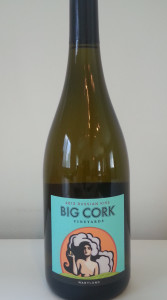Grown In Serbia, Vinted In Maryland, Winner at Indy International
At the recent 2014 Indy International Wine Competition a wine called ‘Russian Kiss” from Big Cork Vineyards in Maryland won Best of Class in the White Vinifera Blend category. Indy International is known for showcasing new and exciting wines, but bestowing such an honor on a wine made from experimental Eastern European grapes is highly unusual. (That four judges selected ‘Russian Kiss” as their ‘Wine of the Year” is even more remarkable.)
Russian Kiss is a blend of Muscat Canelli and two little known grapes called ‘XIV” and ‘SK 77.” According to Big Cork’s general manager Heather Tapper, ‘Two years ago, our winemaker Dave Collins tasted some experimental wines from several unnamed Russian grape varietals. The uniqueness of the Russian grapes led us to the conclusion that they are truly a special discovery in the viticulture world.”
She said that the winery located ‘the only commercial vineyard growing these varietals” in the country, and immediately contracted grapes from them.
‘We have now obtained bud wood from that vineyard, shipped it to a nursery in California for grafting, with plans to plant our own acreage of the Eastern European grapes in 2015,” Tapper said.
According to Wisconsin grape grower and cool climate viticulture authority Mark Hart, it’s likely that the grapes used to make Russian Kiss resulted from the introduction of Eastern European cultivars in Missouri during the ‘90’s.
During this time, Bob Goodman, a Ph.D. plant pathologist from the University of Missouri in Columbia, had a family vineyard in Southern Missouri. He ‘worked tirelessly to import crown gaul resistant grape varieties into this country mainly from the Czech Republic and Ukraine,” according to Dr. Goodman’s 1999 obituary in the journal Phytopathology.
Delving further into the origins of the XIV and SK77 grapes, Hart explains these cultivars probably did not originate in Russia. ‘SK 77 stands for Sremski Karlovci 77″ Hart said, ‘and it comes from Serbia, although it might be growing in Russia now too. ”
‘”77′” stands for 1977, and there are a bunch of grapes that start with that designation,” Hart added. ‘About five cultivars came over in the Missouri importations. Some have names such as Liza, Petra, Rani Rizling, Mila, etc., but others just have a number such as ‘SK 77.’ I suspect the Big Cork wines use either Rani Rizling (SK 77 10/69) or Petra (SK 77 5/3). Both of those have Kunbarat as a parent and are thus 1/8 vitus amurensis.” (Amurensis is a grape species native to China and Russia.)
‘XIV is probably XIV 1-86, a cross of Villard Blanc x Traminer from Ukraine, I believe,” Hart said.
According to a 2007 paper by Joe Masabni and Dwight Wolfe, the University of Kentucky planted XIV-1-86 during 1998 at UK’s Research Station in Princeton along with 16 other Eastern European cultivars. After five years in UK’s vineyard, 87% of the XIV survived and the projected yields were 4.3 tons per acre
According to the UK report, XIV is a “…white grape that is medium to high in vigor with very long thick unbranched canes.”
As for the finished wine, the 2013 vintage of Russian Kiss has .50% residual sugar and notes of honeysuckle and citrus along with a subltle minerality. Although Russian Kiss is primarily a vinifera wine, it does not fit neatly in a traditional white wine category.
Blending the accessibly flavored Muscat with the exotic, higher acid Eastern European grapes produces a unique wine that just has to be tasted. “After fermentation, it was discovered that our Muscat enhanced the uniqueness of the Russian blend…thus the name Russian Kiss,” Tapper said.
During late Fall of 2014, Big Cork Vineyards will open a 4,000 square foot tasting room in Rohrersville Maryland, about 25 miles west of Frederick near the Potomac River. Big Cork grows 13 varietals on 24 acres in Western Maryland including Petit Verdot, Nebbiolo and Vidal.
Home page photo by Heather Tapper.



